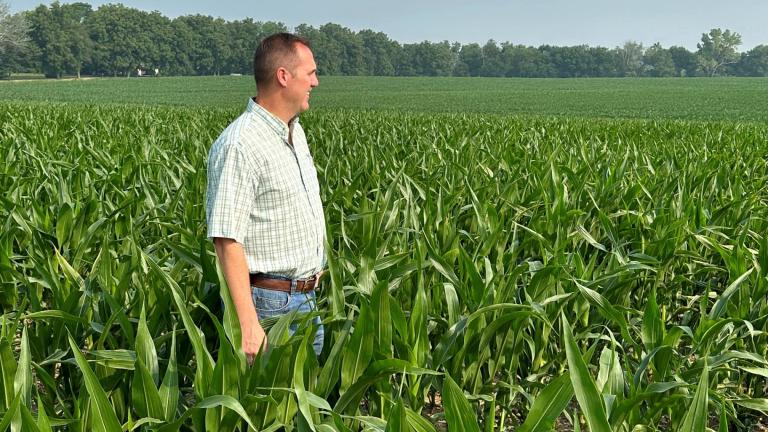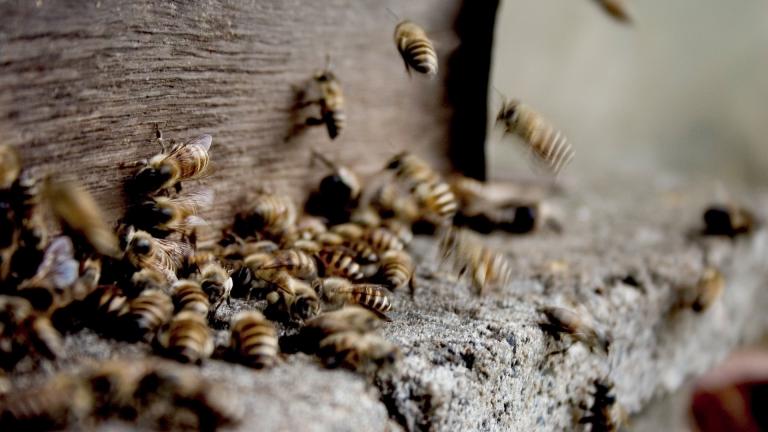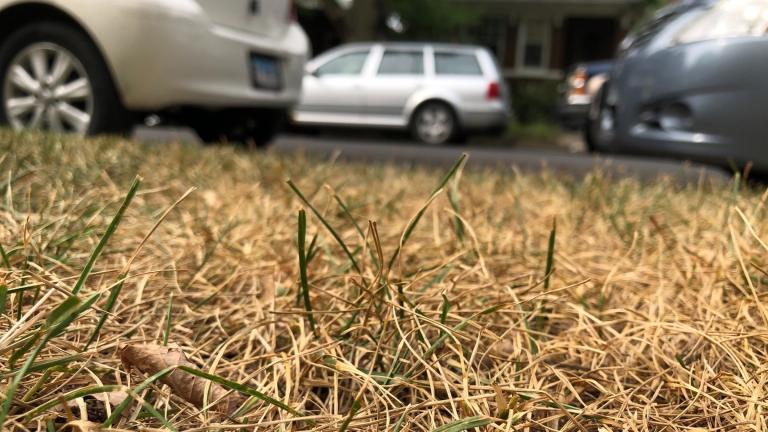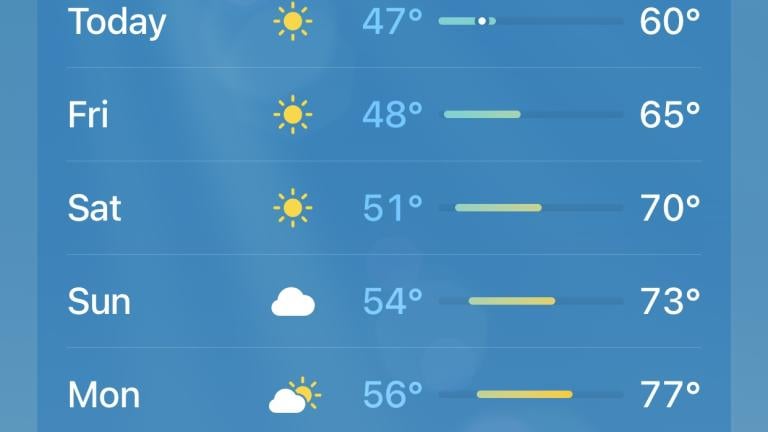Most of Illinois remains in a state of exceptional or extreme drought. And now, farmers are just beginning to get a clear picture of how much damage the severe weather conditions have had on this year’s crop. In tonight’s Scientific Chicago, we travel downstate to see how genetic engineering and technology are playing a part in dealing with drought.
“To really see what you got, you got to get into the field a couple rows. The outside row is always going to look better, but I’m kind of embarrassed to say, that’s the best I could do on my farm this year,” said Manhattan, Illinois farmer John Kiefner about his corn fields.
Kiefner says the lack of rainfall this season coupled with high temperatures has left him with a nearly devastated harvest.
“The make or break time for most corn plants is pollination. It doesn’t matter how much rain we get now, this ear’s already set all the kernels it’s going to,” Kiefner said. “Rain would help make these kernels a little heavier, a little plumper. It will push maybe another 3 or 4 percent onto my yield but the damage is done. My corn crop is very questionable.”
Kiefner has worked these fields for nearly three decades and says this is the worst drought he’s ever experienced. He shows us just how different his corn crop is this year as compared to last.
“Last year, everything went right. Plenty of moisture, wasn’t too hot, the air was pollinated, kernels filling to the tip,” he said. “If I plant 35,000 stalks per acre, I get 35,000 ears like this, I’m going to grow 200-bushel corn. That’s what I want to do this year, but unfortunately…here’s my one-one thousandth of an acre this year. Many ears didn’t pollinate so they don’t even have kernels. All of these stalks are gonna be…all these cobs are never even going to make it in the combine. They’re gonna end up on the ground and be wasted. So I have about 22,000 actual ears out of 35,000 I planted per acre that I’m gonna harvest. And as you can see by comparing, it’s gonna take probably three of these to equal to one.”
But Kiefner considers himself lucky.
“From what I hear, lots of Indiana and Southern Illinois, they can’t even find this,” he said. “They can’t even find an ear.”
More than 60 percent of the continental United States remains under "moderate to exceptional" drought this week. And the further south you go in Illinois – the worse it gets.
According to data collected by the U.S. Drought Monitor, produced jointly by USDA and NOAA at the University of Nebraska in Lincoln, more than 81 percent of the state has reached "extreme" drought conditions – with 8 percent reaching the worst designation of "exceptional" drought.
Emerson Nafziger is a Professor of Crop Sciences at the University of Illinois.
“Certainly in terms of rainfall during the growing season, which is one way to measure it, we’ve been less than half normal rainfall in most of the state of Illinois, since the crop was planted back in April or early May,” Nafziger said. “That’s highly unusual to have it that dry.”
Nafziger says 20-22 inches of water are needed to produce a crop of corn or soybeans in Illinois. And while the soils might hold up to half of that amount, this year – in some areas – that simply has not been enough.
“In terms of weather, we probably have parts of the state that are in just as bad a shape as they were in ’88. Other parts are in worse shape this year,” Nafziger said. “I believe southern Illinois, there they don’t remember ’88 as their worst year. They would have another year in the last three decades that would probably be worse than ’88. But this year is probably setting a new standard in the memory of most people. Not everyone, there are some good places in Illinois. It all depends on where the clouds happened to open up and where they didn’t.”
Because predicting droughts is so unreliable, many farmers have turned toward genetic engineering, in the hopes of salvaging their harvests with a more drought-tolerant crop.
In a research test field in South Central Illinois, about 250 miles southwest of Chicago, kernel development or “silking” as its known, is just beginning.
“These plants right here are just now silking. They were delayed because of the stress and no moisture, so they just now are putting silks out and the rest of the field is done and filling kernels,” said Kelli Bassett, area agronomist in Central Illinois of Pioneer Hi-Bred.
The DuPont-owned seed company specializes in genetically modified products that are meant to be more resilient when water is in short supply. Today, Bassett is taking stock of how well these hybrids were able to retain water in a field that had the advantage of being planted later in the season.
“We had an environment here in 2012 that is proving that those plants that have better water utilization are going to do better in this environment,” Bassett said. “These ears right here are from a hybrid that’s a product that has a high water utilization score from our company, as well as these two ears right here. You’ll notice that they are smaller and they don’t look perfect, but in comparison these ears on this side are ones from products that don’t have that ability to utilize the water in the same manner as these over here.”
As the extreme drought continues, many farmers like Ed Marburger credit advances in seed technology for having any corn harvest at all.
“I’m actually surprised at what we have, which is just fodder, but the modern technology does keep the plant viable,” Marburger said. “Normally, under old standards, this plant would be dead. But we have kept it alive, and if the pollination would have been complete, we would have had corn. But this year, the cycle was off, the pollination wasn’t there, so we lost this crop.”
And while these hybrids can help produce a more robust crop, farmers agree they haven’t gotten to the point where they can withstand long bouts of extreme heat and dryness.
“We want to think it made a big difference, but until we get into the fields and actual harvest, we’re not going to know what did the best,” Kiefner said. “But I’m sure the researchers that are developing those – if they find what they’ve done, we’re going to see those results. Is it possible we just were asking a little bit too much given how hot and dry it was? I suppose that’s the case.”
The USDA’s latest estimate predicts corn farmers will average 123.4 bushels per acre, down nearly 17 percent from last year in what would be the lowest average yield since 1995.
“Even with the good hybrids we have this year, we have fields in Illinois that are not going to produce any yield whatsoever, and that’s an indication that in the end no matter how good the hybrids are, severe enough stress will actually keep them from yielding anything,” Nafziger said.
Bassett says the search for a more resilient crop lies in understanding its weaknesses. In the case of corn this year, she says the crops were unable to pollinate because when temperatures reached upwards of 100 degrees this summer, the pollen literally dried out before it could get the silk.
“You can’t control Mother Nature in all environments. We can prepare the best that we can and try and have everything available to us, but we can’t control the weather and that’s one thing that farmers inherently understand because so much of their livelihood is dependent upon what happens with the weather,” Bassett said.
Having realistic expectations when science can’t contend with Mother Nature has saved some farmers like John Kiefner from economic ruin. He purchased crop insurance that will offset his losses. And despite the tough year, he remains optimistic.
“I guess we’re just going to have to take care of each of ‘em as best we can, because next year we’re going to come back and we’re going to grow a damn good crop,” Kiefner said.







